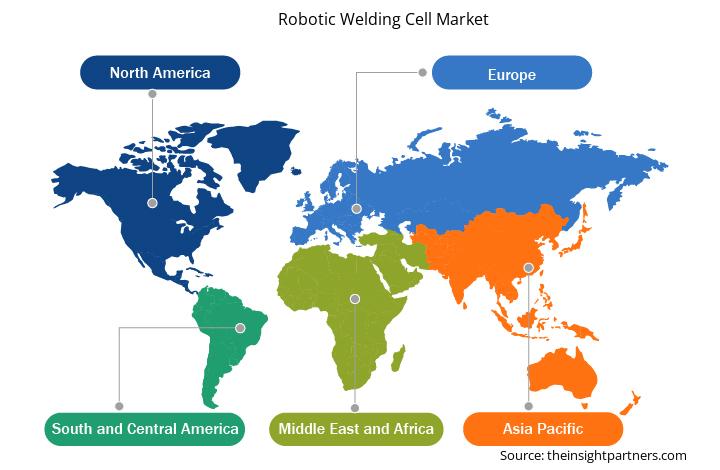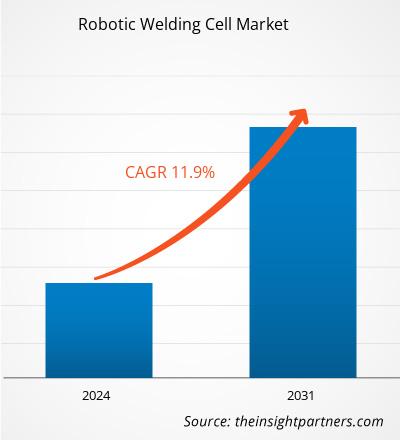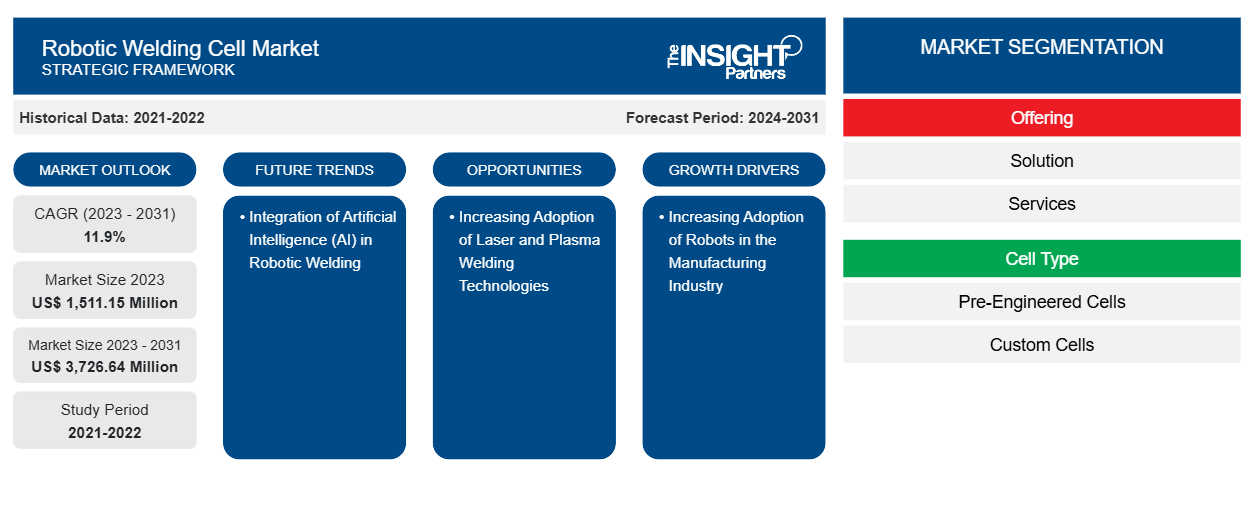Se proyecta que el tamaño del mercado de celdas de soldadura robótica alcance los 3.726,64 millones de dólares en 2031, frente a los 1.511,15 millones de dólares en 2023. Se espera que el mercado registre una CAGR del 11,9 % durante el período 2023-2031. Es probable que la creciente adopción de tecnologías de la Industria 4.0 traiga nuevas tendencias clave al mercado en los próximos años.
Análisis del mercado de células de soldadura robótica
Una celda de soldadura robótica consta de varios componentes que trabajan juntos para soldar piezas. Las celdas de soldadura robótica proporcionan operaciones de soldadura de primera clase y están diseñadas según estándares globales para ahorrar costos y tiempo al operador. Las celdas prediseñadas son celdas de soldadura robóticas rentables e incluyen solo los componentes esenciales básicos necesarios para los procesos de soldadura. Esta estructura básica de las celdas se puede instalar rápidamente; permite a los fabricantes reducir el tiempo de producción de la celda y entregar el producto final lo antes posible. Las celdas personalizadas son caras en comparación con las celdas prediseñadas, ya que incluyen equipos únicos junto con componentes esenciales básicos. Estas se fabrican principalmente de acuerdo con los intereses específicos del cliente. Por lo tanto, el tiempo necesario para fabricar y entregar una celda de soldadura robótica personalizada es mayor que el de una celda prediseñada. Los robots de soldadura se utilizan ampliamente en la industria automotriz. La demanda de vehículos está aumentando notablemente. El aumento del gasto de los consumidores es uno de los factores que impulsa la demanda de vehículos en todo el mundo, especialmente en los países asiáticos. Según los datos publicados por la Organización Internacional de Fabricantes de Vehículos Motorizados en 2024, la producción total de vehículos alcanzó los 93 millones en 2023, un aumento del 12% entre 2021 y 2023. El aumento en la construcción de nuevas instalaciones ha provocado una mayor demanda de robots de soldadura en estas nuevas instalaciones automotrices, lo que en última instancia impulsa el mercado de celdas de soldadura robóticas.
Descripción general del mercado de células de soldadura robótica
Los principales actores en el ecosistema del mercado global de celdas de soldadura robótica incluyen proveedores de materias primas/componentes, fabricantes de celdas de soldadura robótica, organizaciones gubernamentales, organismos reguladores y clientes finales. Los proveedores de componentes y hardware proporcionan varios componentes y piezas a los fabricantes de celdas de soldadura robótica. Los principales fabricantes de celdas de soldadura robótica incluidos en este informe son Abb Ltd, Acieta LLC, Carl Cloos Schweisstechnik Gmbh, Kawasaki Heavy Industries, Ltd; Kuka AG; Phoenix Industrial Solutions; The Lincoln Electric Company; Wec Group Ltd.; y Yaskawa America, Inc.; entre otros. Después de los fabricantes de celdas de soldadura robótica, hay varios actores periféricos en el mercado global de celdas de soldadura robótica, que desempeñan un papel crucial a la hora de permitir los avances tecnológicos y la adopción de celdas de soldadura robóticas.
Personalice este informe según sus necesidades
Obtendrá personalización en cualquier informe, sin cargo, incluidas partes de este informe o análisis a nivel de país, paquete de datos de Excel, así como también grandes ofertas y descuentos para empresas emergentes y universidades.
-
Obtenga las principales tendencias clave del mercado de este informe.Esta muestra GRATUITA incluirá análisis de datos, desde tendencias del mercado hasta estimaciones y pronósticos.
Factores impulsores y oportunidades del mercado de las células de soldadura robótica
La creciente adopción de robots en la industria manufacturera
Los robots desempeñan un papel importante en la industria manufacturera. Los robots ayudan a aumentar la eficiencia y la productividad generales en las operaciones de producción. Se utilizan en la industria manufacturera para diversas aplicaciones, como ensamblaje y dispensación, manipulación y selección, mecanizado y corte, soldadura y soldadura blanda, fundición y moldeo, acabado y lijado, pintura y revestimiento, limpieza e higiene, logística y almacenamiento, y embalaje y paletización. Según los datos publicados por la Federación Internacional de Robótica en 2024, aproximadamente 4,2 millones de robots operaban en fábricas de todo el mundo en 2023, un aumento de los 3,9 millones en 2022. Como afirmó la Federación Internacional de Robótica en 2021, la mitad del total de robots que trabajan en fábricas se utilizará para aplicaciones de soldadura. Por lo tanto, la creciente adopción de robots en la industria manufacturera está impulsando el crecimiento del mercado de celdas de soldadura robóticas.
Adopción creciente de tecnologías de soldadura por láser y plasma
La demanda de soldadura láser está aumentando rápidamente. La tecnología de soldadura láser utiliza rayos láser de alta energía desarrollados con dióxido de carbono, nitrógeno y helio. Esto ayuda a unir los materiales con alta precisión y velocidad. La popularidad de la soldadura láser está aumentando debido a las distorsiones mínimas y la capacidad de soldar diferentes materiales. Además, al mejorar la eficiencia del láser y optimizar el proceso de soldadura, se puede lograr una conservación general de la energía con este tipo de tecnología de soldadura. Este es uno de los factores importantes que está aumentando la demanda de soldadura láser, ya que la reducción del consumo de energía es una de las principales preocupaciones en todo el mundo.
Además, cuando se integra con tecnologías avanzadas como IA y ML, esta tecnología de soldadura puede funcionar de manera eficiente. Por lo tanto, la demanda de tecnología de soldadura láser está aumentando notablemente. De manera similar, la tecnología de soldadura por plasma ofrece varias ventajas, que incluyen alta densidad de potencia, soldaduras limpias y suaves, alta velocidad de soldadura, baja distorsión y mejor puenteo de espacios. Las soldaduras producidas mediante soldadura por plasma son muy fuertes y menos visibles.
Análisis de segmentación del informe de mercado de células de soldadura robótica
Los segmentos clave que contribuyeron a la derivación del análisis del mercado de celdas de soldadura robótica son la oferta, el tipo de celda y la industria de uso final.
- Según la oferta, el mercado mundial de celdas de soldadura robóticas se divide en soluciones y servicios. El segmento de soluciones representó una mayor participación de mercado en 2023 y se espera que registre una CAGR más alta durante el período de pronóstico. Las soluciones de celdas de soldadura robóticas ayudan a los fabricantes a lograr su capacidad de producción adicional y mitigar los problemas de escasez de mano de obra. Estas ventajas de las celdas de soldadura robóticas sobre los procesos de soldadura manuales están impulsando la demanda de celdas de soldadura robóticas.
- Según el tipo de celda, el mercado global de celdas de soldadura robótica se segmenta en celdas prediseñadas y celdas personalizadas. El segmento de celdas prediseñadas dominó el segmento de tipo de celda con una participación de mercado del 68,3 % en 2023, y se estima que el segmento de celdas personalizadas registrará una CAGR más alta durante el período de pronóstico. Las celdas de soldadura robóticas prediseñadas son celdas de soldadura robóticas estándar que tienen un espacio de trabajo más grande con un manipulador de robot más largo y dos mesas más grandes. Por otro lado, las celdas personalizadas se fabrican de acuerdo con los requisitos del usuario final y se personalizan para industrias específicas.
- Según la industria de uso final, el mercado mundial de celdas de soldadura robóticas se segmenta en automoción, fabricación y aeroespacial y defensa. El segmento automotriz representó la segunda participación más grande del mercado y se proyecta que registre la tasa de crecimiento más alta durante el período de pronóstico. Uno de los factores que impulsa la demanda de la industria automotriz es el aumento de la producción y las ventas de vehículos en todo el mundo. Se anticipa que la industria manufacturera registre una CAGR notable durante el período de pronóstico. Uno de los factores que impulsa la demanda de celdas de soldadura robóticas en el segmento de fabricación es la creciente tendencia a la industrialización en todo el mundo, especialmente en los países en desarrollo.
Análisis de la cuota de mercado de las células de soldadura robótica
El alcance geográfico del informe de mercado de células de soldadura robótica ofrece un análisis detallado por región y país. América del Norte, Europa y Asia Pacífico son las principales regiones que están experimentando un crecimiento significativo en el mercado de células de soldadura robótica. China representó casi el 60% de la participación de mercado en el número total de instalaciones de robots en 2022. China instaló ~0,2 millones de robots en 2022, mientras que Japón instaló más de 50.000 unidades en 2022, el segundo mercado más grande a nivel mundial. Aparte de China y Japón, Singapur, India y Tailandia son algunos de los principales mercados de Asia Pacífico.
Europa representó la segunda mayor participación de mercado en instalaciones de robots industriales y en la industria de celdas de soldadura robóticas. Alemania fue el mayor mercado de Europa para celdas de soldadura robóticas y robots industriales en 2023. Uno de los factores que impulsa la demanda de celdas de soldadura robóticas es el enfoque en aumentar la adopción de tecnologías de la Industria 4.0 en Alemania. Alemania, Francia, el Reino Unido e Italia son algunos de los países con una participación notable en el mercado de celdas de soldadura robóticas.
Norteamérica es uno de los mercados más destacados para las celdas de soldadura robóticas debido a la presencia de unas cuantas empresas manufactureras importantes en todos los sectores, la mayor necesidad de la Industria 4.0 y el aumento de la demanda de tecnología avanzada. Estados Unidos representó la mayor parte del mercado debido a las tendencias de industrialización y digitalización en el país. Además, Estados Unidos alberga algunas importantes empresas de fabricación de automóviles y aeroespacial, como Tesla, Boeing y Ford Motors.
Perspectivas regionales del mercado de células de soldadura robótica
Los analistas de Insight Partners explicaron en detalle las tendencias y los factores regionales que influyen en el mercado de celdas de soldadura robóticas durante el período de pronóstico. Esta sección también analiza los segmentos y la geografía del mercado de celdas de soldadura robóticas en América del Norte, Europa, Asia Pacífico, Oriente Medio y África, y América del Sur y Central.

- Obtenga datos regionales específicos para el mercado de celdas de soldadura robótica
Alcance del informe de mercado de células de soldadura robótica
| Atributo del informe | Detalles |
|---|---|
| Tamaño del mercado en 2023 | US$ 1.511,15 millones |
| Tamaño del mercado en 2031 | US$ 3.726,64 millones |
| CAGR global (2023 - 2031) | 11,9% |
| Datos históricos | 2021-2022 |
| Período de pronóstico | 2024-2031 |
| Segmentos cubiertos |
Al ofrecer
|
| Regiones y países cubiertos |
América del norte
|
| Líderes del mercado y perfiles de empresas clave |
|
Densidad de actores del mercado de células de soldadura robótica: comprensión de su impacto en la dinámica empresarial
El mercado de celdas de soldadura robóticas está creciendo rápidamente, impulsado por la creciente demanda de los usuarios finales debido a factores como la evolución de las preferencias de los consumidores, los avances tecnológicos y una mayor conciencia de los beneficios del producto. A medida que aumenta la demanda, las empresas amplían sus ofertas, innovan para satisfacer las necesidades de los consumidores y aprovechan las tendencias emergentes, lo que impulsa aún más el crecimiento del mercado.
La densidad de actores del mercado se refiere a la distribución de las empresas o firmas que operan dentro de un mercado o industria en particular. Indica cuántos competidores (actores del mercado) están presentes en un espacio de mercado determinado en relación con su tamaño o valor total de mercado.
Las principales empresas que operan en el mercado de celdas de soldadura robótica son:
- Compañía: ABB Ltd.
- Acieta
- Carl Cloos Schweisstechnik GmbH
- Compañía: Lincoln Electric Holdings Inc.
- Kuka AG
- Industrias pesadas Kawasaki Ltd.
Descargo de responsabilidad : Las empresas enumeradas anteriormente no están clasificadas en ningún orden particular.

- Obtenga una descripción general de los principales actores clave del mercado de celdas de soldadura robótica
Noticias y desarrollos recientes del mercado de células de soldadura robótica
El mercado de celdas de soldadura robóticas se evalúa mediante la recopilación de datos cualitativos y cuantitativos posteriores a la investigación primaria y secundaria, que incluye publicaciones corporativas importantes, datos de asociaciones y bases de datos. A continuación, se enumeran algunos de los desarrollos en el mercado de celdas de soldadura robóticas:
- La nueva celda OmniVance FlexArc Compact de ABB ahorra espacio y agrega flexibilidad a las aplicaciones de soldadura. ABB Ltd. lanzó su OmniVance FlexArc Compact, una nueva celda de aplicación de soldadura más pequeña con mayor flexibilidad, facilidad de uso y mejor integración para ayudar a las empresas a abordar la escasez de mano de obra en soldadura. La OmniVance FlexArc Compact es la celda de soldadura por arco más pequeña de su clase. Su innovador diseño de montaje de robot de pórtico de 45 grados maximiza los parámetros de trabajo del robot al colocarlo en el centro de una plataforma giratoria de tres ejes, acercándolo a la pieza de trabajo. (ABB Ltd., sitio web de la empresa, junio de 2022)
Informe de mercado sobre células de soldadura robóticas: cobertura y resultados
El informe "Tamaño y pronóstico del mercado de células de soldadura robótica (2021-2031)" proporciona un análisis detallado del mercado que cubre las siguientes áreas:
- Tamaño del mercado de células de soldadura robótica y pronóstico a nivel de país para todos los segmentos clave del mercado cubiertos bajo el alcance
- Tendencias del mercado de células de soldadura robótica, así como dinámicas del mercado, como impulsores, restricciones y oportunidades clave
- Análisis PEST y FODA detallados
- Análisis del mercado de células de soldadura robótica que cubre las tendencias clave del mercado, el marco de cada país, los principales actores, las regulaciones y los desarrollos recientes del mercado
- Análisis del panorama de la industria y de la competencia que abarca la concentración del mercado, el análisis de mapas de calor, los actores destacados y los desarrollos recientes para el mercado de celdas de soldadura robóticas
- Perfiles detallados de empresas
- Análisis histórico (2 años), año base, pronóstico (7 años) con CAGR
- Análisis PEST y FODA
- Tamaño del mercado, valor/volumen: global, regional y nacional
- Industria y panorama competitivo
- Conjunto de datos de Excel
Informes recientes
Informes relacionados
Testimonios
Razón para comprar
- Toma de decisiones informada
- Comprensión de la dinámica del mercado
- Análisis competitivo
- Información sobre clientes
- Pronósticos del mercado
- Mitigación de riesgos
- Planificación estratégica
- Justificación de la inversión
- Identificación de mercados emergentes
- Mejora de las estrategias de marketing
- Impulso de la eficiencia operativa
- Alineación con las tendencias regulatorias























 Obtenga una muestra gratuita para - Mercado de células de soldadura robótica
Obtenga una muestra gratuita para - Mercado de células de soldadura robótica